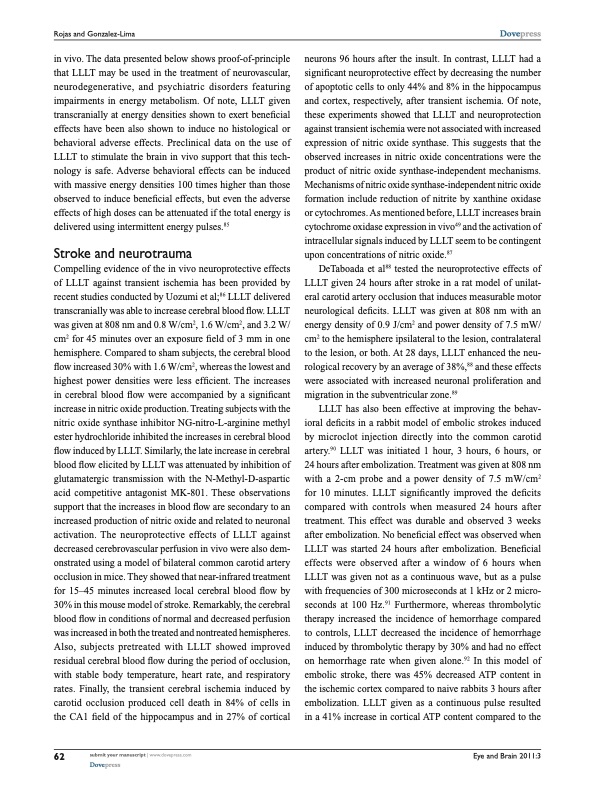
PDF Publication Title:
Text from PDF Page: 014
Rojas and Gonzalez-Lima Dovepress in vivo. The data presented below shows proof-of-principle that LLLT may be used in the treatment of neurovascular, neurodegenerative, and psychiatric disorders featuring impairments in energy metabolism. Of note, LLLT given transcranially at energy densities shown to exert beneficial effects have been also shown to induce no histological or behavioral adverse effects. Preclinical data on the use of LLLT to stimulate the brain in vivo support that this tech- nology is safe. Adverse behavioral effects can be induced with massive energy densities 100 times higher than those observed to induce beneficial effects, but even the adverse effects of high doses can be attenuated if the total energy is delivered using intermittent energy pulses.85 Stroke and neurotrauma Compelling evidence of the in vivo neuroprotective effects of LLLT against transient ischemia has been provided by recent studies conducted by Uozumi et al;86 LLLT delivered transcranially was able to increase cerebral blood flow. LLLT was given at 808 nm and 0.8 W/cm2, 1.6 W/cm2, and 3.2 W/ cm2 for 45 minutes over an exposure field of 3 mm in one hemisphere. Compared to sham subjects, the cerebral blood flow increased 30% with 1.6 W/cm2, whereas the lowest and highest power densities were less efficient. The increases in cerebral blood flow were accompanied by a significant increase in nitric oxide production. Treating subjects with the nitric oxide synthase inhibitor NG-nitro-L-arginine methyl ester hydrochloride inhibited the increases in cerebral blood flow induced by LLLT. Similarly, the late increase in cerebral blood flow elicited by LLLT was attenuated by inhibition of glutamatergic transmission with the N-Methyl-D-aspartic acid competitive antagonist MK-801. These observations support that the increases in blood flow are secondary to an increased production of nitric oxide and related to neuronal activation. The neuroprotective effects of LLLT against decreased cerebrovascular perfusion in vivo were also dem- onstrated using a model of bilateral common carotid artery occlusion in mice. They showed that near-infrared treatment for 15–45 minutes increased local cerebral blood flow by 30% in this mouse model of stroke. Remarkably, the cerebral blood flow in conditions of normal and decreased perfusion was increased in both the treated and nontreated hemispheres. Also, subjects pretreated with LLLT showed improved residual cerebral blood flow during the period of occlusion, with stable body temperature, heart rate, and respiratory rates. Finally, the transient cerebral ischemia induced by carotid occlusion produced cell death in 84% of cells in the CA1 field of the hippocampus and in 27% of cortical neurons 96 hours after the insult. In contrast, LLLT had a significant neuroprotective effect by decreasing the number of apoptotic cells to only 44% and 8% in the hippocampus and cortex, respectively, after transient ischemia. Of note, these experiments showed that LLLT and neuroprotection against transient ischemia were not associated with increased expression of nitric oxide synthase. This suggests that the observed increases in nitric oxide concentrations were the product of nitric oxide synthase-independent mechanisms. Mechanisms of nitric oxide synthase-independent nitric oxide formation include reduction of nitrite by xanthine oxidase or cytochromes. As mentioned before, LLLT increases brain cytochrome oxidase expression in vivo49 and the activation of intracellular signals induced by LLLT seem to be contingent upon concentrations of nitric oxide.87 DeTaboada et al88 tested the neuroprotective effects of LLLT given 24 hours after stroke in a rat model of unilat- eral carotid artery occlusion that induces measurable motor neurological deficits. LLLT was given at 808 nm with an energy density of 0.9 J/cm2 and power density of 7.5 mW/ cm2 to the hemisphere ipsilateral to the lesion, contralateral to the lesion, or both. At 28 days, LLLT enhanced the neu- rological recovery by an average of 38%,88 and these effects were associated with increased neuronal proliferation and migration in the subventricular zone.89 LLLT has also been effective at improving the behav- ioral deficits in a rabbit model of embolic strokes induced by microclot injection directly into the common carotid artery.90 LLLT was initiated 1 hour, 3 hours, 6 hours, or 24 hours after embolization. Treatment was given at 808 nm with a 2-cm probe and a power density of 7.5 mW/cm2 for 10 minutes. LLLT significantly improved the deficits compared with controls when measured 24 hours after treatment. This effect was durable and observed 3 weeks after embolization. No beneficial effect was observed when LLLT was started 24 hours after embolization. Beneficial effects were observed after a window of 6 hours when LLLT was given not as a continuous wave, but as a pulse with frequencies of 300 microseconds at 1 kHz or 2 micro- seconds at 100 Hz.91 Furthermore, whereas thrombolytic therapy increased the incidence of hemorrhage compared to controls, LLLT decreased the incidence of hemorrhage induced by thrombolytic therapy by 30% and had no effect on hemorrhage rate when given alone.92 In this model of embolic stroke, there was 45% decreased ATP content in the ischemic cortex compared to naive rabbits 3 hours after embolization. LLLT given as a continuous pulse resulted in a 41% increase in cortical ATP content compared to the Eye and Brain 2011:3 62 submit your manuscript | www.dovepress.com DovepressPDF Image | Low-level light therapy of the eye and brain

PDF Search Title:
Low-level light therapy of the eye and brainOriginal File Name Searched:
Low-level_light_therapy_of_the_eye_and_brain.pdfDIY PDF Search: Google It | Yahoo | Bing
Cruise Ship Reviews | Luxury Resort | Jet | Yacht | and Travel Tech More Info
Cruising Review Topics and Articles More Info
Software based on Filemaker for the travel industry More Info
The Burgenstock Resort: Reviews on CruisingReview website... More Info
Resort Reviews: World Class resorts... More Info
The Riffelalp Resort: Reviews on CruisingReview website... More Info
| CONTACT TEL: 608-238-6001 Email: greg@cruisingreview.com | RSS | AMP |